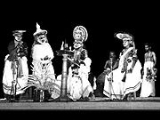
Koodiyattam
Encyclopedia
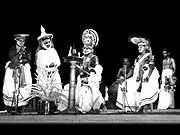
Kerala
or Keralam is an Indian state located on the Malabar coast of south-west India. It was created on 1 November 1956 by the States Reorganisation Act by combining various Malayalam speaking regions....
, India
India
India , officially the Republic of India , is a country in South Asia. It is the seventh-largest country by geographical area, the second-most populous country with over 1.2 billion people, and the most populous democracy in the world...
. Performed in the Sanskrit language in Hindu
Hindu
Hindu refers to an identity associated with the philosophical, religious and cultural systems that are indigenous to the Indian subcontinent. As used in the Constitution of India, the word "Hindu" is also attributed to all persons professing any Indian religion...
temples, it is believed to be 2,000 years old. It is officially recognised by UNESCO
UNESCO
The United Nations Educational, Scientific and Cultural Organization is a specialized agency of the United Nations...
as a Masterpiece of the Oral and Intangible Heritage of Humanity
Masterpieces of the Oral and Intangible Heritage of Humanity
The Proclamation of Masterpieces of the Oral and Intangible Heritage of Humanity was made by the Director-General of UNESCO starting in 2001 to raise awareness on intangible cultural heritage and encourage local communities to protect them and the local people who sustain these forms of cultural...
.
Origin
Koodiyattam [kutiyattam], meaning "combined acting," signifies Sanskrit drama presented in the traditional style in temple theatres of Kerala and Tamil Nadu. It is the only surviving specimen of the ancient Sanskrit theatre. It has an attested history of a thousand years in Kerala, but its origin and evolution are shrouded in mystery. Kutiyattam and chakyar koothu were among the dramatized dance worship services in temples of ancient India, particularly Tamilakam (modern-day Tamil Nadu and Kerala). Both kootiyattam and chakyar koothu find several mentions in ancient sangam literature of south and also in the epigraphs belonging to subsequent Pallava, Chera, Chola periods in Tamilnadu. Inscriptions related to the dramatized dance worship services like koodiyattam and chakyar koothu are available in temples at Tanjore, Tiruvidaimaruthur, Vedaranyam, Tiruvarur, and Omampuliyur. They were treated as an integral part of worship services alongside the singing of tevaram and prabandam hymns. There are mentions in epigraphs those forms of dramatized dance worship services that are called aariyam that mostly had Sanskrit scripts for plays.Several ancient kings and members of other professions are listed to have authored several works for these services. There is evidence of these services being done all over ancient subcontinent during time of cholas and pallavas. A Pallava king called Rajasimha has been credited with authoring a play called kailasodharanam in Tamil that has the topic of Ravana becoming subject to Siva's anger and being subdued mercilessly for the same. For examples a fragmented inscription at the door step of an ancient Shiva temple (now non-existent) in Pegan in Burma finds mention of these services.
It is believed that Kulasekhara Varman Cheraman Perumal, an ancient king of Tamil Chera dynasty, who ruled from Mahodayapuram (modern Kodungallur
Kodungallur
Kodungallur is a municipality in Thrissur District, in the state of Kerala, India on the Malabar Coast. Kodungallur is located about 29 km northwest of Kochi city and 38 km Southwest of Thrissur, on National Highway 17 . Muziris the ancient seaport at the mouth of the Periyar River was...
), reformed Koodiyattam, introducing the local language for Vidusaka and structuring presentation of the play to well-defined units. He himself wrote two plays, Subhadraharana and Tapatisamvarana and made arrangements for their presentation on stage with the help of a Brahmin
Brahmin
Brahmin Brahman, Brahma and Brahmin.Brahman, Brahmin and Brahma have different meanings. Brahman refers to the Supreme Self...
friend called Tolan. These plays are still presented on stage. Apart from these, the plays traditionally presented include Ascaryacudamani of Saktibhadra, Kalyanasaugandhika of Nilakantha, Bhagavadajjuka of Bodhayana, Nagananda of Harsa, and many plays ascribed to Bhasa
Bhasa
Bhāsa is one of the earliest and most celebrated Indian playwrights in Sanskrit. However, very little is known about him.Kālidāsa in the introduction to his first play Malavikagnimitram writes -...
including Abhiseka and Pratima. The Kutiyattam performance was performed in specially designed temples called koothambalams.
The use of Buddhist themes for plays is a very controversial and moot issue and seem to be a later interpolation not existing since ancient times for the latter not being a then-legal vedic system.
Instruments used
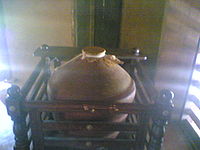
Performance style

Chakyar
Chakyar is a Brahmin caste coming under the Ambalavasi community of Hindus in the Kerala state of South India. The women in this caste are called Illotammas....
s (a subcaste of Kerala Hindu
Hindu
Hindu refers to an identity associated with the philosophical, religious and cultural systems that are indigenous to the Indian subcontinent. As used in the Constitution of India, the word "Hindu" is also attributed to all persons professing any Indian religion...
s) and by Nangyaramma (women of the Ambalavasi
Ambalavasi
Ambalavasi is a generic name for a collection of castes among Hindus in Kerala who render temple services.-Etymology:The term Ambalavasi is derived from two Malayalam words, being Ambalam and Vasi...
Nambiar caste
Nambiar (Ambalavasi/Mizhavu)
Nambiar and Chakyar in the context of temple art forms like Chakyar koothu, Koodiyattam, Ottanthullal and similar cultural things refers to the Hindu community in the state of Kerala, India, belonging to the Ambalavasi community. Members of this Ambalavasi community undergo Upanayanam...
). The name Koodiyattam (meaning "playing together") suggests a combined performance of Chakyar and Nangyar. The main actor is a Chakyar who performs the ritualistic Koothu
Koothu
Koothu , means dance or performance in Tamil language, is a folk art originated from the early Tamil country. But more precisely Koothu refers Therukoothu that is street dance or street play since it will be performed village squares. At early age the art of entertainment reached its peak in...
and Koodiyattam inside the temple or in the Koothambalam
Koothambalam
Koothambalam' or Kuttampalam is a theater hall for staging Koothu , Nangiar koothu and Koodiyattam, the ancient dramatic art forms of Kerala, India. Koothambalams are constructed according to the guide lines given in the chapter 2 of Nātyasāstra of Bharata Muni. The hall is considered to be as...
. Chakyar women, Illotammas, are not allowed to participate. Instead, the female roles are played by Nangyaramma.
The practice was that elders of the Chakyar
Chakyar
Chakyar is a Brahmin caste coming under the Ambalavasi community of Hindus in the Kerala state of South India. The women in this caste are called Illotammas....
community taught it to their youngsters and it was an art form performed only by Chakyar
Chakyar
Chakyar is a Brahmin caste coming under the Ambalavasi community of Hindus in the Kerala state of South India. The women in this caste are called Illotammas....
s till the 1950s. In 1955 Guru Mani Madhava Chakyar
Mani Madhava Chakyar
Guru Mani Madhava Chakyar was a celebrated master performance artist and Sanskrit scholar from Kerala, South India, considered to be the greatest Chakyar Koothu and Koodiyattam artist and authority of modern times...
performed Kutiyattam outside the temple for the first time. For performing the art forms outside the temples he faced many problems from the hardline Chakyar community. In his own words:
"My own people condemned my action (performing Koothu and Kutiyattam outside the precincts of the temples), Once, after I had given performances at Vaikkom, they even thought about excommunicating me.
I desired that this art should survive the test of time. That was precisely why I ventured outside the temple"
In 1962, under the leadership of Dr. V. Raghavan, noted art and Sanskrit scholar, Sanskrit Ranga of Madras, invited Guru Mani Madhava Chakyar to perform Kutiyattam in Chennai. Thus for the first time in history Kutiyattam was performed outside Kerala.
They presented at Madras on three nights: Kutiyattam scenes from three plays Abhiṣeka, Subhadrādhanañjaya and Nāgānda.
The performance of the maestro Maani Maadhava Chakyar made great impact on the people and art critics so that Kutiyattam and Mani Madhava Chakyar became famous outside Kerala. People outside Kerala were able to witness the talent of the maestro. Then Mani Madhava Chakyar was invited and performed Kutiyattam at places in north India like New Delhi and Banaras (1964). It made the critic to accept his authority in Rasa Abhinaya, Natyasastra and Kutiyattam.
After Chakyar's first tour to New Delhi, he was awarded immediately with Sangeet Natak Akademi Award
Sangeet Natak Akademi Award
Sangeet Natak Akademi Puraskar is an award given by the Sangeet Natak Akademi, India's National Academy of Music, Dance & Drama. It is the highest Indian recognition given to practicing artists. The award consists since 2003 of Rs. 50,000, a citation, an angavastram , and a tamrapatra...
in 1964 for his "contributions to Chakyar Koothu and Kutiyattam" — the first national recognition to the maestro and the art form. His supremacy in Rasa-abhinaya and Netrabhinaya and Kutiyattam became very famous and attracted lot of people towards the art form.
He performed Kudiyattam all over India and popularized the same. He and his troop did Koodiyattam performance in places like Madras
Chennai
Chennai , formerly known as Madras or Madarasapatinam , is the capital city of the Indian state of Tamil Nadu, located on the Coromandel Coast off the Bay of Bengal. Chennai is the fourth most populous metropolitan area and the sixth most populous city in India...
(1962, 1973 and 1977), Madhura
Madhura
Madhu is a word used in several Indo-Aryan languages meaning honey or sweet. It also means mead and is used for alcohol. The word originates in Sanskrit and has cognates in most Indo-European languages.-Alcohol and mead:...
(1962), New Delhi
New Delhi
New Delhi is the capital city of India. It serves as the centre of the Government of India and the Government of the National Capital Territory of Delhi. New Delhi is situated within the metropolis of Delhi. It is one of the nine districts of Delhi Union Territory. The total area of the city is...
(1964, 1966, 1974, 1979 and 1983), Varanasi (1964 and 1979), Bombay
Mumbai
Mumbai , formerly known as Bombay in English, is the capital of the Indian state of Maharashtra. It is the most populous city in India, and the fourth most populous city in the world, with a total metropolitan area population of approximately 20.5 million...
(1973), Ujjain
Ujjain
Ujjain , is an ancient city of Malwa region in central India, on the eastern bank of the Kshipra River , today part of the state of Madhya Pradesh. It is the administrative centre of Ujjain District and Ujjain Division.In ancient times the city was called Ujjayini...
(1982), Bhopal (1987), etc.
The President of India
President of India
The President of India is the head of state and first citizen of India, as well as the Supreme Commander of the Indian Armed Forces. President of India is also the formal head of all the three branches of Indian Democracy - Legislature, Executive and Judiciary...
, scholar and philosopher, Sarvepalli Radhakrishnan
Sarvepalli Radhakrishnan
Sir Sarvepalli Radhakrishnan , OM, FBA was an Indian philosopher and statesman. He was the first Vice President of India and subsequently the second President of India ....
invited him to perform Kutiyattam at Rashtrapati Bhavan
Rashtrapati Bhavan
The Rashtrapati Bhavan or The Official Residence of the Head of the State is the official residence of the President of India, located at Raisina hill in New Delhi, India. Until 1950 it was known as "Viceroy's House" and served as the residence of the Viceroy and Governor-General of India...
(presidential palace) in 1964 and was impressed by the guru's exceptional acting skill. His Kutiyattam performances, lectures and demonstrations at centres like Madras Music Academy in Chennai, International Centre for Kathakali in New Delhi, Experimental theatre in New Delhi and Bombay, and National Centre for the Performing Arts
National Centre for the Performing Arts (India)
The National Centre for the Performing Arts , in Mumbai, India was established with a grant of Rs 4 million from the Sir Dorabji Tata Trust. This was later supplemented by donations from the corporate sector...
in Bombay fetched wide popularity and recognition for his Abhinaya and Kutiyattam.

Kalidasa
Kālidāsa was a renowned Classical Sanskrit writer, widely regarded as the greatest poet and dramatist in the Sanskrit language...
's Abhijñānaśākuntala, Vikramorvaśīya and Mālavikāgnimitra ; Bhasa
Bhasa
Bhāsa is one of the earliest and most celebrated Indian playwrights in Sanskrit. However, very little is known about him.Kālidāsa in the introduction to his first play Malavikagnimitram writes -...
's Swapnavāsavadatta
Swapnavasavadatta
Svapnavasavadatta is a Sanskrit play in six acts written by the ancient Indian poet Bhasa. It is probably the best known of Bhāsa's works...
and Pancharātra
Pancharatra
Pancharātra is a Sanskrit drama written by Bhasa. The plot is based on the Hindu epic Mahabharata....
; Harsha
Harsha
Harsha or Harsha Vardhana or Harshvardhan was an Indian emperor who ruled northern India from 606 to 647 AD. He was the son of Prabhakara Vardhana and younger brother of Rajya Vardhana, a king of Thanesar, Haryana...
's Nagananda
Nagananda
Nagananda is a Sanskrit play attributed to king Harsha .Nagananda is one of the best Sanskrit dramas in five acts dealing with the popular story of Jimutavahana's self-sacrifice to save the Nagas...
for the first time in the history of Koodiyattam. He and his troupe performed these Kutiyattams all over India.
He performed Chakyar Koothu and Koodiyattam for All India Radio
All India Radio
All India Radio , officially known since 1956 as Akashvani , is the radio broadcaster of India and a division of Prasar Bharati. Established in 1936, it is the sister service of Prasar Bharati's Doordarshan, the national television broadcaster. All India Radio is one of the largest radio networks...
and Doordarshan
DoorDarshan
Doordarshan is an Indian public service broadcaster, a division of Prasar Bharati. It is one of the largest broadcasting organizations in India in terms of the infrastructure of studios and transmitters. Recently, it has also started Digital Terrestrial Transmitters. On September 15, 2009,...
for the first time, which helped to attract thousands of listeners to these traditional art forms. It was he who started demonstrations
Demonstration (people)
A demonstration or street protest is action by a mass group or collection of groups of people in favor of a political or other cause; it normally consists of walking in a mass march formation and either beginning with or meeting at a designated endpoint, or rally, to hear speakers.Actions such as...
in Kudiyattam to popularise the same.
In early 1960s Maria Christoffer Byrski, a Polish student doing research in Indian theatres at Banaras Hindu University
Banaras Hindu University
Banaras Hindu University is a public university located in Varanasi, India and is one of the Central Universities of India. It is the largest residential university in Asia, with over 24,000 students in its campus. BHU was founded in 1916 by Pandit Madan Mohan Malviya under the Parliamentary...
came to study Koodiyattam from the maestro Mani Madhava Chakyar and became the first non-Chakyar/nambiar to learn the art form. He stayed in Guru's home at Killikkurussimangalam
Killikkurussimangalam
Killikkurussimangalam is a village around eight km from nearby town Ottappalam in Palakkad district of Kerala, south India. The river Nila flows through the southern border of Lakkidi....
and studied the art form in traditional Gurukula way.
Famous artists

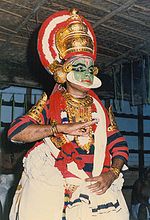
Guru
A guru is one who is regarded as having great knowledge, wisdom, and authority in a certain area, and who uses it to guide others . Other forms of manifestation of this principle can include parents, school teachers, non-human objects and even one's own intellectual discipline, if the...
Mani Madhava Chakyar
Mani Madhava Chakyar
Guru Mani Madhava Chakyar was a celebrated master performance artist and Sanskrit scholar from Kerala, South India, considered to be the greatest Chakyar Koothu and Koodiyattam artist and authority of modern times...
has been the best-known face of Koodiyattam. He was known for mastery of Rasa Abhinaya
Abhinaya
Abhinaya is a concept in Indian dance and drama derived from Bharata's Natya Shastra. Although now, the word has come to mean 'the art of expression', etymologically it derives from Sanskrit abhi- 'towards' + nii- 'leading/guide', so literally it means a 'leading towards' Aside from its clear...
with special reference to Netrābhinaya. He has been a major force in popularizing Koodiyattam by taking it out of the Hindu temples, performing across India with his troupe, and teaching it to non-Chakyar
Chakyar
Chakyar is a Brahmin caste coming under the Ambalavasi community of Hindus in the Kerala state of South India. The women in this caste are called Illotammas....
caste members. He has adapted, choreographed and directed well-known plays such as Kalidasa
Kalidasa
Kālidāsa was a renowned Classical Sanskrit writer, widely regarded as the greatest poet and dramatist in the Sanskrit language...
's The Recognition of Sakuntala, Vikramorvaśīya and Mālavikāgnimitra and Bhasa
Bhasa
Bhāsa is one of the earliest and most celebrated Indian playwrights in Sanskrit. However, very little is known about him.Kālidāsa in the introduction to his first play Malavikagnimitram writes -...
's Swapnavāsadatta and Pancharātra
Pancharatra
Pancharātra is a Sanskrit drama written by Bhasa. The plot is based on the Hindu epic Mahabharata....
for performance in the Koodiyattam style.
Mani Madhava Chakkiar's disciple and nephew Mani Damodara Chakyar
Mani Damodara Chakyar
Mani Damodara Chakyar is a renowned Kutiyattam and Chakyar Koothu artist in Kerala state of south India. He is a nephew and disciple of legendary guru Nātyāchārya Vidūshakaratnam Padma Shri Māni Mādhava Chākyār...
is also a Koodiyattam performer of traditional devotional Koodiyattams, such as Anguliyanka, Mattavilasa, Mantranka, Ezhamanka (seventh act of Ascharyachoodamani).
Any reference to Chakyar Koothu will not be complete without mentioning Painkulam Raman Chakyar. He was the first instructor for Chakyar Koothu when it was started as a course in Kalamadalam.
Related literature and books
- Natyakalpadruma (1975), a Kerala Sahitya Academy Award-winning book on Koodiyattam written by Guru Mani Madhava ChakyarMani Madhava ChakyarGuru Mani Madhava Chakyar was a celebrated master performance artist and Sanskrit scholar from Kerala, South India, considered to be the greatest Chakyar Koothu and Koodiyattam artist and authority of modern times...
, considered authoritative by scholars. - The Nātya ShāstraNatya ShastraThe Natya Shastra is an ancient Indian treatise on the performing arts, encompassing theatre, dance and music. It was written during the period between 200 BC and 200 AD in classical India and is traditionally attributed to the Sage Bharata.The Natya Shastra is incredibly wide in its scope...
, an ancient work of dramatic theory Bharata MuniBharata MuniBharata was an ancient Indian musicologist who authored the Natya Shastra, a theoretical treatise on ancient Indian dramaturgy and histrionics, dated to between roughly 400 BC and 200 BC. Indian dance and music find their root in the Natyashastra...
describes the Sanskrit theatre of the Gupta EmpireGupta EmpireThe Gupta Empire was an ancient Indian empire which existed approximately from 320 to 550 CE and covered much of the Indian Subcontinent. Founded by Maharaja Sri-Gupta, the dynasty was the model of a classical civilization. The peace and prosperity created under leadership of Guptas enabled the...
; Koodiyattam is believed to preserve some aspects of the performance style of that period. - Abhinaya darpana by NandikeshvaraNandikeshvaraNandikeshvara was the great theorist on stage-craft of ancient India, redoubtable rival of Bharata Muni. He was the author of the Abhinaya Darpana .-His Influence on Bhasa:...
,another work of dramatic theory comparable to the Nātya Shāstra. - Farley Richmond, Kutiyattam: Sanskrit Theater of India (University of Michigan Press, 2002). CD-ROM featuring videos and text.
- Rajendran C, "The Traditional Sanskrit Theatre of Kerala "(University of Calicut,1989)
- Virginie Johan, « Kuttu-Kutiyattam : théâtres classiques du Kerala ». Revue d’histoire du théâtre 216, 2002-4: 365-382.
- Virginie Johan, « Pour un théâtre des yeux : l’exemple indien ». Coulisses 33, 2006 : 259-274.
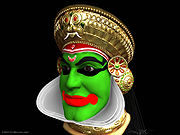
See also
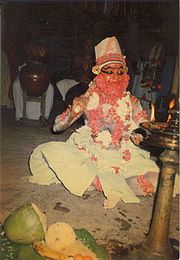
- Mani Madhava ChakyarMani Madhava ChakyarGuru Mani Madhava Chakyar was a celebrated master performance artist and Sanskrit scholar from Kerala, South India, considered to be the greatest Chakyar Koothu and Koodiyattam artist and authority of modern times...
- Mani Damodara ChakyarMani Damodara ChakyarMani Damodara Chakyar is a renowned Kutiyattam and Chakyar Koothu artist in Kerala state of south India. He is a nephew and disciple of legendary guru Nātyāchārya Vidūshakaratnam Padma Shri Māni Mādhava Chākyār...
- NatyakalpadrumamNatyakalpadrumamNātyakalpadrumam is a book written by Nātyāchārya Vidūshakaratnam Padma Shri Guru Māni Mādhava Chākyār about all aspects of ancient Sanskrit drama theatre tradition of Kerala- Kutiyattam...
- Arts of KeralaArts of KeralaThe Indian state of Kerala is well known for its diverse forms of performing arts. The various communities in Kerala contribute to its rich and colorful culture.-Hindu Arts:* Kathakali* Koodiyattom* Theyyam* Thira* Theeyaattam * Mohiniyattam...
- KoothuKoothuKoothu , means dance or performance in Tamil language, is a folk art originated from the early Tamil country. But more precisely Koothu refers Therukoothu that is street dance or street play since it will be performed village squares. At early age the art of entertainment reached its peak in...
- KathakaliKathakaliKathakali is a highly stylized classical Indian dance-drama noted for the attractive make-up of characters, elaborate costumes, detailed gestures and well-defined body movements presented in tune with the anchor playback music and complementary percussion...
- Mohiniyattam
- Thulall
- Bharata MuniBharata MuniBharata was an ancient Indian musicologist who authored the Natya Shastra, a theoretical treatise on ancient Indian dramaturgy and histrionics, dated to between roughly 400 BC and 200 BC. Indian dance and music find their root in the Natyashastra...
- NandikeshvaraNandikeshvaraNandikeshvara was the great theorist on stage-craft of ancient India, redoubtable rival of Bharata Muni. He was the author of the Abhinaya Darpana .-His Influence on Bhasa:...
- Painkulam Raman Chakyar
- "Kutiyattam" by Sudha Gopalakrishnan
External links
- Wikiquote:Guru Mani Madhava Chakyar/Kutiyattam

